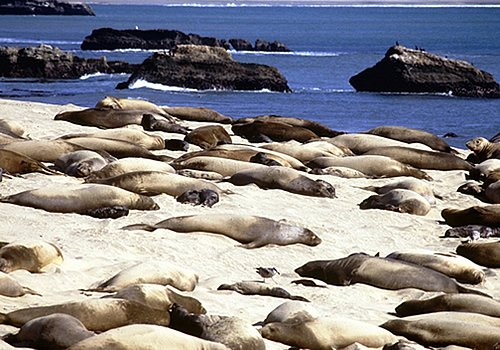
If you’re curious about where you can find these magnificent seals, you’re in for a treat. They inhabit vast areas of the ocean and have specific seasons for breeding and foraging. From the rocky shores of California to the icy regions off the coast of Antarctica, elephant seals have adapted to thrive in various habitats. Let’s dive deeper into their world and explore the different places these stunning animals call home.
The Primary Habitat: Coastal Regions
The majority of elephant seals are found along the coasts of the Pacific Ocean. Their favored spots are often remote beaches that provide a safe environment for them to rest and nurse their young. Northern elephant seals primarily inhabit areas along the California coast, especially from Big Sur to the Channel Islands. This region provides the ideal blend of rugged terrain and access to deep waters teeming with fish, their primary food source.
You might be wondering why these seals are so particular about their habitats. Coastal regions not only offer the sandy beaches they need for resting but also provide essential locations for breeding. During the breeding season, which spans from late winter to early spring, you can see thousands of elephant seals congregating on the same beach, creating a spectacular sight. It’s like watching a large community gathering, with mothers and pups forming tight-knit groups.
Southern Elephant Seals and Antarctica
On the other side of the world, we find the southern elephant seals. These seals are mainly found on sub-Antarctic islands, such as South Georgia and the Falkland Islands. They also populate the coasts of mainland Argentina and parts of Chile. The unique conditions of these habitats allow them to thrive even in the coldest environments.
Southern elephant seals are unique not just because of where they live, but also because of their impressive diving abilities. They hold the record for the deepest dive of any seal, reaching depths of over 5,000 feet! The cold Antarctic waters are rich in nutrients, making them a perfect hunting ground for these amazing creatures. Imagine a seal navigating through dark waters, hunting for squid and fish while braving extreme cold. It’s a tough life, but they make it look easy.
Migration Patterns of Elephant Seals
One of the most intriguing aspects of elephant seals is their migratory behavior. After spending time on the breeding beaches each spring, these seals embark on long migrations that can span thousands of miles. Northern elephant seals travel as far as the Gulf of Alaska for foraging, while southern elephant seals make their way to the rich waters of the Antarctic.
During these migrations, they often travel alone, navigating the open ocean using their impressive swimming skills. They can hold their breath for over an hour while diving, allowing them to reach great depths in search of food. It’s a fascinating and perilous journey that showcases their adaptability and resilience in the face of challenges.
Why Migration Is Important
You might be curious why these migrations are so essential for elephant seals. Simply put, the food supply varies depending on the location and season. By migrating, they can take advantage of abundant food sources while avoiding competition from other predators. It’s nature’s way of ensuring the survival of their species.
Furthermore, their migration patterns provide crucial information about ocean health and the impacts of climate change. Scientists track these migrations to study how environmental changes affect marine life. So, in a way, elephant seals serve as critical indicators for the health of our oceans.
Habitat Disruption and Conservation Efforts
While elephant seals have adapted to various habitats over thousands of years, they face challenges that threaten their survival. Coastal development, pollution, and climate change impact their breeding and foraging grounds. As their habitats are altered or destroyed, it becomes increasingly challenging for these seals to thrive.
Conservation efforts are underway to protect these majestic creatures. Organizations are working to restore beach habitats, reduce pollution, and monitor seal populations. Education and awareness also play a crucial role in protecting elephant seals. By understanding their habitats and the pressures they face, we can take steps to preserve their existence for future generations.
How You Can Help
If you’re passionate about wildlife, you can support conservation efforts in various ways. Here are some practical steps to make a difference:
- Participate in local beach cleanups to reduce pollution.
- Spread awareness about elephant seals and their habitats.
- Support organizations focused on marine conservation.
- Adopt sustainable practices in your daily life.
Every little effort counts. By taking these actions, you’re contributing to the protection of elephant seals and the ecosystems they depend on.
So, where are elephant seals found? They inhabit diverse coastal regions, from the sunny shores of California to the icy landscapes of Antarctica. Their unique migration patterns and adaptability make them some of the ocean’s most remarkable inhabitants. However, as human activities continue to disrupt their habitats, it’s crucial to remain vigilant and support conservation efforts.
Next time you think about these ocean giants, remember the incredible journeys they undertake and the importance of preserving their homes. Elephant seals deserve to thrive in their natural habitats, just as we cherish our own homes. Let’s work together to ensure these magnificent creatures continue to grace our oceans for years to come.
